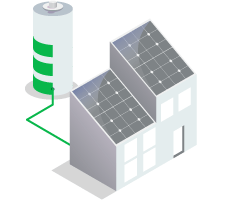Solar Roof Tiles in Australia: What You Need to Know
Solar roof tiles, also known as building-integrated photovoltaics (BIPV), are growing in popularity among Australian homeowners who want the benefits of solar energy without the look of bulky rooftop panels. While they offer a streamlined, aesthetically pleasing design, solar roof tiles tend to be more expensive and less efficient than traditional solar panels. In this guide, we’ll cover how solar roof tiles work, their pros and cons, leading brands available in Australia, and what you can do to reduce the cost of installation.
What Are Solar Roof Tiles?
Solar roof tiles are compact solar units designed to blend into your roof’s structure. Unlike conventional solar panels, which are bolted on top of an existing roof, solar tiles replace sections of your roofing material, functioning both as solar generators and weatherproof coverings. This integration makes them ideal for new builds or major roof renovations.
How Do Solar Roof Tiles Work?
Solar roof tiles operate the same way as standard photovoltaic (PV) panels: they convert sunlight into electricity using a solar inverter. However, because they are built directly into your roof, they provide an additional layer of weather protection and maintain your home’s architectural aesthetic.

Benefits of Solar Roof Tiles
There are many advantages to getting solar roof tiles compared to regular solar PV panels. Here are some of the top benefits for homeowners:
- Great for difficult roof shapes: If your roof is oddly shaped or positioned in a way that makes panel installation tricky, solar tiles could be a better fit.
- Less intrusive installation: Since they replace parts of your roof, there’s no need for clamps, rails, or drilling.
- Weather resistance: Solar tiles are designed to handle extreme weather better than some panel systems. They’re also more walkable than panels.
- Visual appeal: Many homeowners choose solar tiles for their ability to blend into modern rooflines without looking like add-ons.
Disadvantages of Solar Roof Tiles
There are some disadvantages of solar roof tiles, these include:
- Higher upfront cost: Solar tiles are still a niche product in Australia, and this is reflected in their price. Installing a 4kW solar tile system can cost between $6,000 and $15,700, compared to around $4,920 for traditional solar panels.
- Longer payback period: With average payback times of over 20 years, solar tiles are a long-term investment.
- More complex installation: Installing solar tiles is more labor-intensive and typically takes 5–14 days, compared to 1–3 days for solar panels.
- Harder to repair and maintain: Fewer companies offer maintenance for solar tiles, and repairs can be more complicated.
- Lower efficiency: Solar tiles generally convert 10–20% of sunlight into electricity—less than the 15–25% efficiency of conventional solar panels.
Solar Roof Tiles vs Solar Panels: Cost Comparison
Since solar roof tiles are still a relatively new and emerging technology in Australia, they tend to come with significantly higher upfront costs compared to traditional solar panels. This is largely due to limited market availability, more complex installation requirements, and fewer manufacturers producing these integrated systems.
| Factor | Solar Roof Tiles | Solar Panels |
|---|---|---|
| Installation (4kW system) | $6,000–$15,700 | ~$4,920 |
| Price per Watt | $3–$8 | ~$0.90 |
| Average Payback Time | 20+ years | 2–6 years |
Top Solar Roof Tile Brands in Australia
- Volt x Bristile Roofing: Volt’s solar tiles are only compatible with select Bristile roof tiles. System sizes range from 6kW to 15kW.
- Nulok: Offers a solar tile product compatible only with its own tile and slate roofing systems.
- Tractile: Known for integrating solar hot water systems with their solar tiles, increasing energy output.
- Tesla and Monier: Both previously offered solar tiles but appear to no longer have them available in Australia.
Looking for a Solar Quote or the cheapest Solar Panel Installation?
Click now or call our providers to find the cheapest deal for your needs!
Reducing the Cost of Solar Roof Tiles in Australia
If you’re set on solar tiles, you may be eligible for government subsidies through the Small-scale Renewable Energy Scheme (SRES). This program provides rebates via small-scale technology certificates (STCs) for approved systems.

To qualify, you must:
- Use a Solar Accreditation Australia-certified installer.
- Choose a solar roof tile system listed on the Clean Energy Council (CEC) approved modules list.
As of early 2025, only Volt’s solar tiles are listed, though these approvals are set to expire by June 30th due to changing standards. Keep an eye out for updates, as new tile models could be approved in future.

Anker Solix offers reliable solar panels, along with batteries and generators to keep your home powered on or off the grid. Their scalable battery systems and portable solar generators make it easy to capture and store solar energy for everyday use or backup needs.
Solar roof tiles offer a stylish alternative to traditional solar panels, but they come with higher costs and lower efficiency. If you’re building a new home or completely re-roofing, they could be a good option—especially if aesthetics and seamless design are important to you. However, if saving money and getting a faster return on investment are your priorities, standard solar panels still remain the more practical choice.
Frequently Asked Questions
What are solar roof tiles?
Solar roof tiles, or BIPV, are integrated solar units that replace sections of your roof, combining power generation with weatherproof roofing for a seamless design.
How do solar roof tiles work?
They convert sunlight into electricity like conventional solar panels but are built into the roof itself, providing both energy generation and protection.
What are the pros and cons of solar roof tiles?
Pros include aesthetics, weather resistance, and durability. Cons include higher cost, lower efficiency, longer payback, complex installation, and limited repair options.
How do solar roof tiles compare with traditional solar panels?
Solar tiles are more expensive and less efficient but offer superior aesthetics. Panels are cheaper, provide higher efficiency, and faster installation but are more noticeable.
What are some popular solar roof tile brands in Australia?
Brands include Volt integrated with Bristile Roofing, Nulok, Tractile, and previous offerings from Tesla and Monier.
How can I reduce the cost of solar roof tiles?
Take advantage of government rebates like the Small-scale Renewable Energy Scheme, ensure your installer and products are Clean Energy Council approved.
[custom_block:CTA_AllComparisonServices_Monetization_Content

